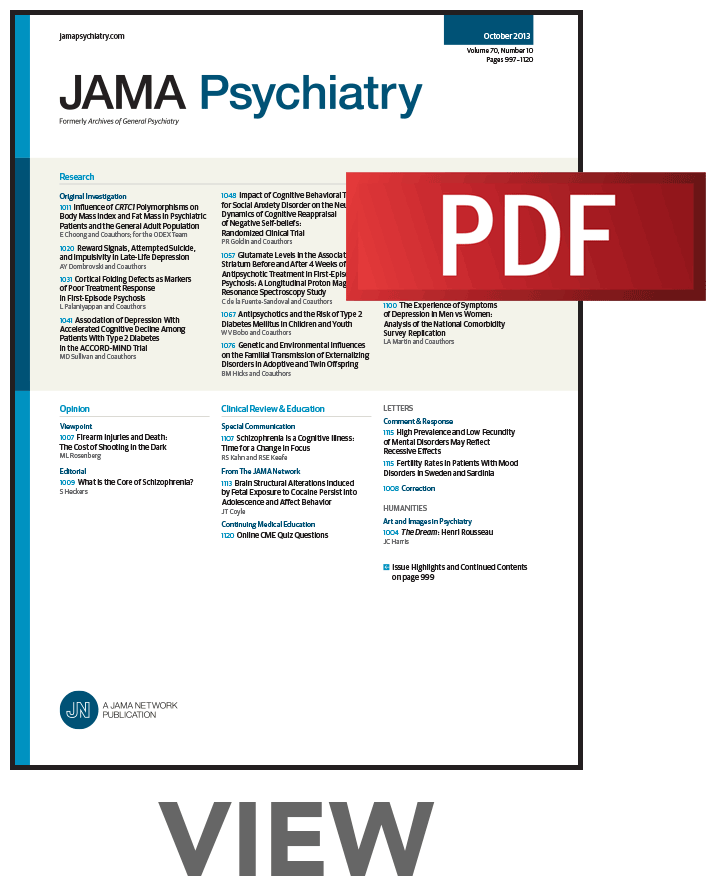Framework for Brain-Derived Dimensions of Psychopathology.
IF 17.1
1区 医学
Q1 PSYCHIATRY
引用次数: 0
Abstract
Importance Psychiatric diagnoses are not defined by neurobiological measures hindering the development of therapies targeting mechanisms underlying mental illness. Research confined to diagnostic boundaries yields heterogeneous biological results, whereas transdiagnostic studies often investigate individual symptoms in isolation. Objective To develop a framework that groups clinical symptoms compatible with ICD-10 and DSM-5 according to their covariation and shared brain mechanisms. Design, Setting, and Participants This diagnostic study was conducted in 2 samples, the population-based Reinforcement-Related Behaviour in Normal Brain Function and Psychopathology (IMAGEN) cohort (longitudinal assessments at 14, 19, and 23 years; study duration from March 2010 to the present) and the cross-diagnostic Brain Network Based Stratification of Mental Illness (STRATIFY)/Earlier Detection and Stratification of Eating Disorders and Comorbid Mental Illnesses (ESTRA) samples (study duration from October 2016 to September 2023). The samples are from 8 clinical research hospitals in Germany, the UK, France, and Ireland. For the population-based IMAGEN study, 794 of 1253 23-year-old participants had complete assessments including complete clinical assessments and neuroimaging data across all time points. For the cross-diagnostic STRATIFY/ESTRA samples, 209 of 485 participants aged 18 to 26 years had complete clinical and neuroimaging data. The sample included healthy control individuals and patients with alcohol use disorder, major depressive disorder, anorexia nervosa, and bulimia nervosa. Exposures Sparse generalized canonical correlation analysis was used to integrate diverse data from clinical symptoms and 7 brain imaging modalities. Main Outcomes and Measures The prediction of symptom features was the main outcome. The model was developed in the training set from the IMAGEN Study at age 23 years (70%), then applied in the remaining holdout test sample (30%), the independent STRATIFY/ESTRA patient sample, and longitudinally in the IMAGEN set. Results In total, 1003 participants were included (425 male and 578 female; mean [SD] age, 22.1 [1.5] years). The reassembly of existing ICD-10 and DSM-5 symptoms revealed 6 cross-diagnostic psychopathology scores. They were consistently associated with multimodal neuroimaging components: excitability and impulsivity (training set: r, 0.26; 95% CI, 0.18-0.33; test set: r, 0.22; 95% CI, 0.10-0.35; STRATIFY/ESTRA set: r, 0.19; 95% CI, 0.07-0.31), depressive mood and distress (training: r, 0.30; 95% CI, 0.20-0.38; test: r, 0.22; 95% CI, 0.09-0.35; STRATIFY/ESTRA: r, 0.19; 95% CI, 0.04-0.33), emotional and behavioral dysregulation (training: r, 0.40; 95% CI, 0.31-0.48; test: r, 0.17; 95% CI, 0.14-0.36; STRATIFY/ESTRA: r, 0.19; 95% CI, 0.06-0.30), stress pathology (training: r, 0.32; 95% CI, 0.19-0.43; test: r, 0.14; 95% CI, 0.05-0.23; STRATIFY/ESTRA: r, 0.12; 95% CI, 0.01-0.22), eating pathology (training: r, 0.34; 95% CI, 0.25-0.42; test: r, 0.26; 95% CI, 0.15-0.37; STRATIFY/ESTRA: r, 0.15; 95% CI, 0.12-0.34), and social fear and avoidance symptoms (training: r, 0.31; 95% CI, 0.25-0.42; test: r, 0.18; 95% CI, 0.15-0.35; STRATIFY/ESTRA: r, 0.12; 95% CI, 0.12-0.33). Conclusion and Relevance In this study, the identification of symptom groups of mental illness robustly defined by precisely characterized brain mechanisms enabled the characterization of dimensions of psychopathology based on quantifiable neurobiological measures.精神病理学脑源性维度框架。
精神疾病诊断不是由神经生物学测量来定义的,这阻碍了针对精神疾病潜在机制的治疗方法的发展。局限于诊断界限的研究产生异质的生物学结果,而跨诊断研究往往孤立地调查个体症状。目的根据ICD-10和DSM-5的共变和共享脑机制对临床症状进行分类。设计、环境和参与者本诊断研究在2个样本中进行,即正常脑功能和精神病理学(IMAGEN)队列中基于人群的强化相关行为(纵向评估14、19和23岁;研究时间为2010年3月至今)和基于交叉诊断脑网络的精神疾病分层(STRATIFY)/饮食失调和共病精神疾病早期检测和分层(ESTRA)样本(研究时间为2016年10月至2023年9月)。样本来自德国、英国、法国和爱尔兰的8家临床研究医院。在基于人群的IMAGEN研究中,1253名23岁的参与者中有794人完成了完整的评估,包括完整的临床评估和所有时间点的神经影像学数据。对于交叉诊断的STRATIFY/ESTRA样本,485名18至26岁的参与者中有209人具有完整的临床和神经影像学数据。样本包括健康对照个体和患有酒精使用障碍、重度抑郁症、神经性厌食症和神经性贪食症的患者。使用稀疏广义典型相关分析来整合来自临床症状和7种脑成像模式的各种数据。主要结局和措施症状特征的预测是主要结局。该模型在来自IMAGEN研究的23岁(70%)的训练集中开发,然后应用于剩余的holdout测试样本(30%),独立的STRATIFY/ESTRA患者样本,并纵向应用于IMAGEN集。结果共纳入受试者1003人,其中男性425人,女性578人;平均[SD]年龄22.1[1.5]岁)。现有ICD-10和DSM-5症状的重组显示了6个交叉诊断的精神病理评分。它们始终与多模态神经成像成分相关:兴奋性和冲动性(训练集:r, 0.26;95% ci, 0.18-0.33;检验集:r, 0.22;95% ci, 0.10-0.35;STRATIFY/ESTRA集合:r, 0.19;95% CI, 0.07-0.31),抑郁情绪和痛苦(训练:r, 0.30;95% ci, 0.20-0.38;检验:r, 0.22;95% ci, 0.09-0.35;STRATIFY/ESTRA: r, 0.19;95% CI, 0.04-0.33),情绪和行为失调(训练:r, 0.40;95% ci, 0.31-0.48;检验:r为0.17;95% ci, 0.14-0.36;STRATIFY/ESTRA: r, 0.19;95% CI, 0.06-0.30),应激病理学(训练:r, 0.32;95% ci, 0.19-0.43;检验:r, 0.14;95% ci, 0.05-0.23;STRATIFY/ESTRA: r, 0.12;95% CI, 0.01-0.22),饮食病理学(训练:r, 0.34;95% ci, 0.25-0.42;检验:r, 0.26;95% ci, 0.15-0.37;STRATIFY/ESTRA: r, 0.15;95% CI, 0.12-0.34),以及社交恐惧和回避症状(训练:r, 0.31;95% ci, 0.25-0.42;检验:r, 0.18;95% ci, 0.15-0.35;STRATIFY/ESTRA: r, 0.12;95% ci, 0.12-0.33)。结论与意义在本研究中,通过精确表征的脑机制来确定精神疾病的症状组,使得基于可量化的神经生物学测量的精神病理维度的表征成为可能。
本文章由计算机程序翻译,如有差异,请以英文原文为准。
求助全文
约1分钟内获得全文
求助全文
来源期刊

JAMA Psychiatry
PSYCHIATRY-
CiteScore
30.60
自引率
1.90%
发文量
233
期刊介绍:
JAMA Psychiatry is a global, peer-reviewed journal catering to clinicians, scholars, and research scientists in psychiatry, mental health, behavioral science, and related fields. The Archives of Neurology & Psychiatry originated in 1919, splitting into two journals in 1959: Archives of Neurology and Archives of General Psychiatry. In 2013, these evolved into JAMA Neurology and JAMA Psychiatry, respectively. JAMA Psychiatry is affiliated with the JAMA Network, a group of peer-reviewed medical and specialty publications.
 求助内容:
求助内容: 应助结果提醒方式:
应助结果提醒方式:


